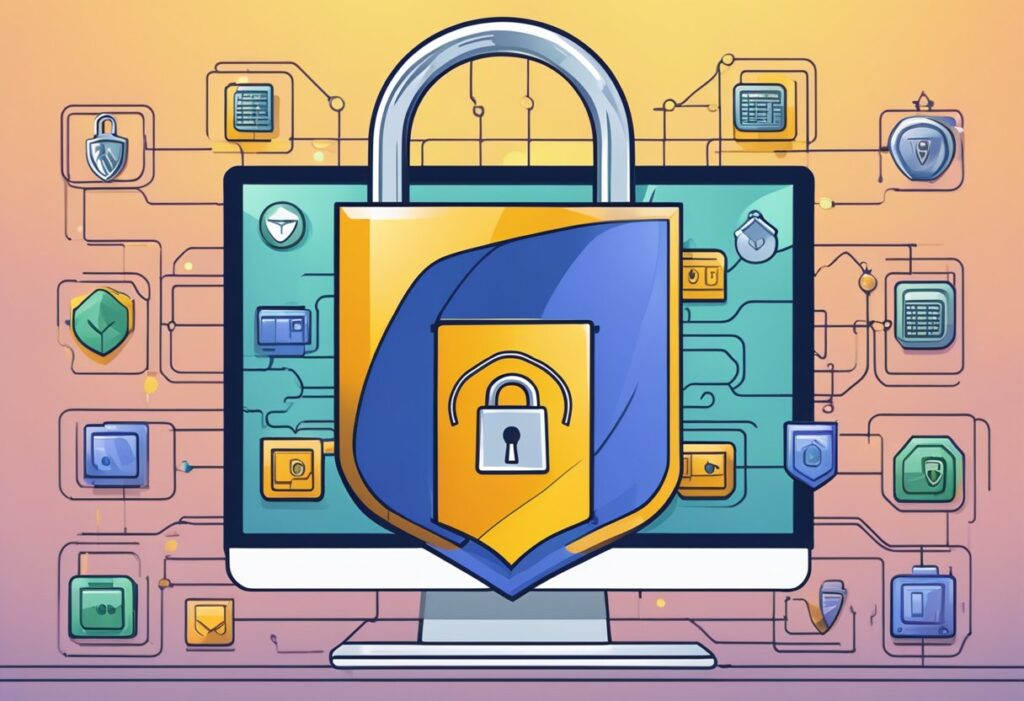A lot of developers these days focus solely on designing beautiful websites. A beautiful website is nice. However, you must also learn how to build a secure WordPress site.
Ensuring the security of a WordPress site is an essential step for any site owner or administrator. 43% of websites on the internet are powered by WordPress, which often becomes a target for hackers and malicious activities. Security measures range from choosing the right hosting environment to implementing regular maintenance procedures. A secure WordPress site not only protects your data and users but also preserves your reputation and safeguards against potentially expensive recoveries.

Today, I will teach you how to build a secure WordPress site so you can have sound sleep without your site being exposed to attack.
Key Takeaways
- Security is multi-faceted, involving proper hosting, plugins, and user protocols.
- Regular updates and maintenance are critical for a robust defence.
- Data protection relies on strong access controls and backup strategies.
11 Tips on How To Build A Secure WordPress Site
Table of Contents
Choose a Reliable Hosting Provider
When setting up a WordPress site, choosing a reliable hosting provider is very important. They should offer high uptime, robust security features, and knowledgeable support. Additionally, specialized hosting solutions can significantly enhance your website’s security posture.
Here are two ways how to make a WordPress site secure with the right hosting:
- Managed WordPress Hosting
- Security Enhanced Server Configuration
1. Managed WordPress Hosting
Managed WordPress Hosting provides a solution specifically optimized for WordPress. It often includes automatic updates, backups, and enhanced security. Providers like Bluehost, Namecheap and GoDaddy specialize in managed WordPress hosting. They offer automated scanning for vulnerabilities and assist with the proactive management of security threats.
2. Security-Enhanced Server Configuration
Choosing a hosting provider with security-enhanced server configurations is important. Look for options such as firewalls, intrusion detection systems, and DDoS mitigation. Reliable hosting providers employ a multi-layered approach to secure and protect your website from various online threats.
Install and Configure Security Plugins
Installing and configuring security plugins can help you have a secure WordPress site. This process involves setting up firewalls and conducting regular malware scans.
3. Set Up Firewalls
One of the first steps in building a secure WordPress is to implement a Web Application Firewall (WAF). A WAF serves as a protective barrier between a website and all incoming traffic.
For example, the WAF can block malicious requests before they reach the site. You can set up a firewall by choosing a security plugin like Wordfence or Malcare that offers WAF functionality and follow the plugin’s installation and configuration instructions.
For instance, this guide on WordPress security shows how to easily setup your site’s defences with a WAF.
4. Regular Malware Scanning
Malware scanning helps detect any security breaches before they cause significant damage. You should establish a regular schedule for automated scans using a reliable security plugin.
Most security plugins come with settings that allow you to configure frequent scans and select the types of files to inspect.
Moreover, these scans can often be supplemented with additional security measures, as outlined by the HubSpot Blog on steps to secure a WordPress site, recommending the installation of reputable security plugins for comprehensive protection.
Regular Maintenance and Updates
Ensuring the security of a WordPress site hinges on diligent maintenance and timely updates. These practices are the bedrock of a well-protected website.
5. WordPress Core Updates
WordPress frequently releases updates to enhance security, add new features, and improve performance. You need to apply these updates as soon as they become available. It’s advisable to create a local backup of your WordPress site and apply updates locally first to avoid any disruptions on the live site.
6. Plugin and Theme Updates
Just as the WordPress core requires regular updates, so do plugins and themes. Outdated plugins and themes can create vulnerabilities. You must routinely check for and install updates, which often include security patches.
Remove unused plugins and themes to minimize potential entry points for attackers. It’s also beneficial to use reputable sources for plugins and themes to reduce the risk of installing malicious software.
Strengthening User Access Control
When building a secure WordPress site, you need to be strict with user access control. It ensures that only authorized users can access certain areas within the site, and they do so with robust authentication measures in place.
7. Complex Password Policies
You should enforce strong password requirements to enhance security.Use complex passwords containing a mix of uppercase letters, lowercase letters, numbers, and special characters. They should also be of significant length, ideally more than twelve characters. Users can be prompted to update their passwords periodically, and the use of previous passwords can be restricted.
8. Implement Two-Factor Authentication
Two-factor authentication (2FA) adds an additional layer of security by requiring users to provide two forms of identification before gaining access.
One common method combines something the users know (like a password) with something they have (such as a mobile device).
Ensuring that even if a password is compromised, unauthorized access is still prevented. WordPress plugins are available to implement 2FA on a WordPress site, providing this critical security feature.
Securing Data with Backups and Encryption

Ensuring the security of a WordPress site involves implementing robust measures for data protection. Among these, regular scheduled backups and data encryption through SSL/TLS are best practices that safeguard against data loss and unauthorized access.
9. Scheduled Backups
Maintaining scheduled backups is a good defence strategy.
Configure your WordPress site to automatically create backups on a daily, weekly, or monthly basis, depending on the frequency of site updates. A reliable backup system can be the lifeline in the event of a website compromise, allowing you to restore the site to a previous state effortlessly.
Plugins and hosting services frequently offer integrated backup solutions, making it relatively straightforward to establish this safety net.
10. Using SSL/TLS for Data Encryption
SSL/TLS encryption is integral for securing data transferred between the user’s browser and the WordPress hosting server. Implement an SSL certificate to ensure that sensitive information, such as login credentials and personal data, is encrypted and less susceptible to interception by malicious actors.
WordPress site owners must ensure that their hosting provider supports SSL/TLS and that their site is configured to operate over HTTPS. This not only provides a layer of security but also instils trust among visitors and can positively impact search engine rankings.
Customizing .htaccess for Additional Security
The .htaccess file is an essential tool to make a WordPress site secure. Administrators can add extra protection by inserting specific directives that dictate the server’s behaviour. While editing this file, precision is crucial as mistakes may render a website inaccessible.
Limiting Directory Access
You should ensure that directory browsing is disabled to prevent outsiders from viewing sensitive files. You can achieve this by adding the following to your .htaccess file:
Options -Indexes
Enforcing SSL Usage
Transitioning a site to HTTPS is fundamental for security. By inserting the code below, all traffic is redirected to use SSL:
RewriteEngine On
RewriteCond %{SERVER_PORT} 80
RewriteRule ^(.*)$ https://www.yourdomain.com/$1 [R,L]
Securing System Files
To protect critical WordPress files like wp-config.php, the following directive can be included:
<files wp-config.php>
order allow,deny
deny from all
</files>
Blocking Suspicious IPs
If there are numerous attempted breaches from specific IP addresses, they can be blocked by:
Order Allow,Deny
Deny from [IP Address 1]
Deny from [IP Address 2]
Allow from all
For a more comprehensive approach to securing WordPress through .htaccess, reviewing professional guides or security resources can prove invaluable. Create a backup before making changes to the .htaccess file to prevent potential site access issues.
Frequently Asked Questions
What are the best practices for securing WordPress websites?
The best practices for securing WordPress websites include regularly updating all software, such as themes, plugins, and the WordPress core itself. Also, use strong passwords and choose a reputable hosting provider that prioritizes security.
How can I prevent unauthorized access to my WordPress site?
To prevent unauthorized access, you should use secure wp-admin login credentials, implement two-factor authentication, limit login attempts, and monitor user activity.
How can I implement HTTPS to improve the security of my WordPress site?
You can implement HTTPS by obtaining an SSL certificate and configuring the website to force all traffic through the secure protocol. This ensures encrypted communication. Also, it protects data exchange between the user’s browser and the website.
How can hosting affect the safety of a WordPress website?
Secure hosting impacts the safety of a WordPress website by providing infrastructure with advanced security measures, like firewalls, security scans, and regular backups. A secure host is proactive in defending against threats and quickly mitigating any attacks.
What can I check to maintain ongoing WordPress site security?
A checklist for ongoing security should include tasks such as regular updates for themes and plugins, scheduled backups, security scans for malware, and reviewing user privileges and access regularly.
What measures should I take to monitor the security of a WordPress website?
Regular measures to monitor security include setting up system alerts for suspicious activity, conducting periodic security audits, and utilizing security plugins that provide regular monitoring and reports on the health and security of the WordPress site.
